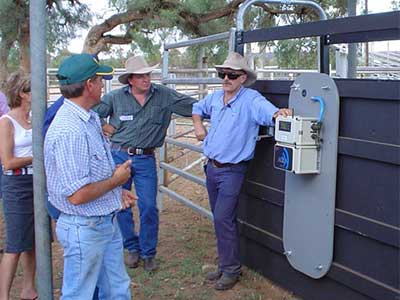Say farewell Crawf!

Having joined the Northern Territory Government (NTG) on 15 March 1982 at the peak of the National Brucellosis and Tuberculosis Eradication Campaign (BTEC), Greg Crawford has spent just shy of 40 years with the NTG. Prior to this, he had worked on New Crown, Mt Doreen and Numery Stations in Central Australia, in addition to spending two years on a cattle ranch in Arizona.
‘Crawf’ as he is affectionately known, initially occupied the role of the Alice Springs ‘Town Stocky’, a position that included supervising loading cattle onto trains for movement south in addition to culling animals on tuberculosis-quarantined properties.
In 2001, Crawf travelled to the United Kingdom (UK) with a group of Territory vets and stockmen (stockies) to participate in the UK FMD Eradication Programme. Posted to the wilds of Cumbria meant they had to familiarise themselves with the local dialect, in addition to being 26km from the nearest town. He found the experience to be a great eye-opener and described it as “scary as hell”. Previously, he had thought that BTEC was a big exercise but he was blown away by the scale of the UK’s FMD response. Crawf indicated it was definitely something we never want to see in Australia. He found the opportunity to work with vets and other livestock staff from all over the world to be a fantastic experience.
After BTEC, Crawf joined the Pastoral group as an extension adviser until he transferred back to Livestock Biosecurity in 2005 as the Regional Stock Inspector, soon to be redesignated as the Regional Biosecurity Officer. His arrival coincided with the introduction of the National Livestock Identification System (NLIS). His previous knowledge of the industry was to prove invaluable in convincing producers of the benefits of the NLIS system. His persistence succeeded when producers started recognising that their cattle were being moved to slaughter without their knowledge – something everyone had suspected but now had evidence of.
In 2007, Crawf answered the call yet again, with other Territory vets and stockies, to assist Queensland during the equine influenza outbreak. His previous experience was well recognised as he took on more and more responsibilities in the Control Centre.
With the introduction of the NLIS, Livestock Biosecurity gradually focused more on compliance, and Crawf evolved his skillset to meet the new order. He became the ‘go-to’ person for all matters NLIS, and his knowledge of its database workings was extensive. His ability to trace animals from the paddock to the plate was legendary and widely recognised, as was his ability to issue infringement notices.
In recent years, Crawf has represented the Territory on a number of national committees, a role that at times he found both equally satisfying and frustrating. Replacing Crawf will be extremely difficult and we’re sad to see him go.
Crawf and his wife plan to move to South Australia to be closer to family and we wish them well for the future. We thank him for the outstanding contribution he has made to the Territory cattle industry, especially in Central Australia.
